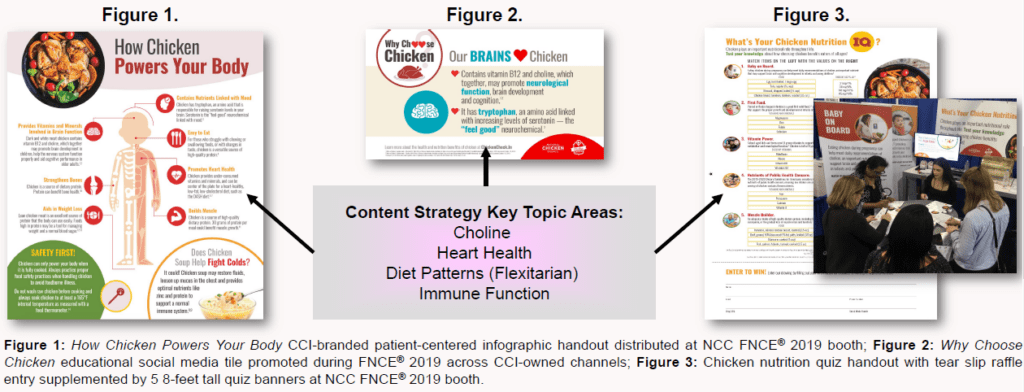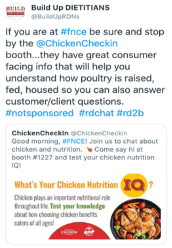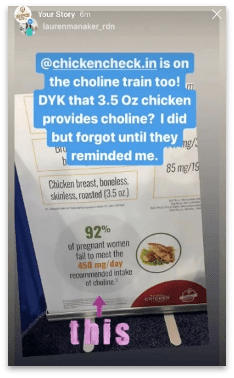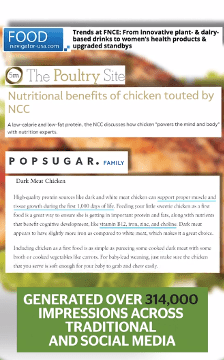Think about how much chicken you eat in a year. If you’re like the average American, that’s estimated to be some 96.1 pounds of chicken. You may find yourself buying so much chicken because, compared to other sources of protein, you’ve heard that it’s healthier, more convenient, has better family appeal, is affordable and even tastes better.

But other than it being a great source of protein, how much do you really know about the nutritional value of chicken? What source can consumers turn to and trust to learn more about their favorite protein?
A recent program for our client, the National Chicken Council, involved creating breakthrough nutrition education content to address these questions through the lens of both health care professionals and consumers. Here are a few things I learned along the way:
Find the White Space
Finding the white space across existing resources is a critical first step for creating nutrition education content that breaks through, as it positions you to fill identified gaps with novel information right where your target audience is already looking.
Chicken Check In, the online communications platform from the National Chicken Council, was already doing a great job clarifying misconceptions and educating consumers and healthcare professionals on a variety of topics, including how chickens are raised and processed.
But despite interest in information and resources about the nutritional value of chicken from healthcare professionals and consumers, a white space analysis of the Chicken Check In website and social media profiles revealed more could be done to highlight the nutritional value of chicken. This insight informed the overarching program development and content strategy.
Identify the Right Audience and Moment
Consumers and patients trust health care professionals, specifically registered dietitians, for information about which foods to eat or avoid. They’re the gatekeepers of public opinion about food and nutrition. For that reason, registered dietitians became our target audience.
Food & Nutrition Conference & Expo™ (FNCE®) is the world’s largest meeting of food and nutrition experts, with more than 10,000 registered dietitians ready to learn about the latest trends and research in food and nutrition. The 2019 event was the right moment to launch our materials, increase awareness about Chicken Check In as an online resource and engage our target audience of registered dietitians in a meaningful, approachable and applicable way. The registered dietitians were already active in seeking out new information to bring back to their audience.
Meet Evidence-Based Information with Consumer Insights
All breakthrough nutrition communications materials start by ensuring that the latest scientific evidence is met with consumer insights. It’s critical to pull through key topics of interest for both consumers and the registered dietitians delivering nutrition information to their audience. If the communications program or material is not actionable, it won’t break through among today’s savvy consumers.
To inform content development for our educational materials, we conducted a scientific literature review and cross-referenced it with results of a media audit to categorize chicken nutrition variables and identify key topics of interest. The topics we identified were of interest to our audience and supported by research, but not yet available from other online resources.

Diversify Across Communications Touchpoints
 Leading up to and during FNCE® 2019, we executed a social media campaign supporting the new educational materials that leveraged insights from a nationally recognized nutrition expert. It was deployed across all Chicken Check In owned social media channels to engage with registered dietitians attending the meeting.
Leading up to and during FNCE® 2019, we executed a social media campaign supporting the new educational materials that leveraged insights from a nationally recognized nutrition expert. It was deployed across all Chicken Check In owned social media channels to engage with registered dietitians attending the meeting.
This campaign was paired with an amplified and interactive presence at the National Chicken Council booth, where the Chicken Check In branded nutrition education materials were available in hard copy as well as uploaded online for easy digital access.
Think Interactive
 To ensure the new materials broke through with registered dietitians and would be used after the meeting with their audiences, we made sure myriad interactive and actionable nutrition education assets were available across touchpoints.
To ensure the new materials broke through with registered dietitians and would be used after the meeting with their audiences, we made sure myriad interactive and actionable nutrition education assets were available across touchpoints.
The FNCE® Expo Floor is a fierce competition for share of attention. So to attract attendees to our booth, we made the importance of understanding and discussing the nutritional value of chicken with their audience a life-sized ordeal. Literally – with five eight-feet-tall chicken nutrition quiz banners that supplemented the launch of the nutrition education materials. Booth attendees could answer the chicken nutrition quiz and enter for their chance to win “viral” giveaways like chicken socks or bandanas.
The chicken nutrition quiz was well received and instrumental in filling knowledge gaps among dietitians for our key topic areas. It also reinforced an excitement to download and use the new nutrition education materials with their audience after the meeting ended.
Pull It All Together
Over 350 hard-copy Chicken Check In branded materials were distributed to attendees who visited the National Chicken Council booth.
 Nearly 314,000 impressions were generated across traditional and social media that were related to our core audience of registered dietitians and target consumers. Coverage also pulled through key topic areas, such as the choline content of chicken, that were informed by our overarching content strategy.
Nearly 314,000 impressions were generated across traditional and social media that were related to our core audience of registered dietitians and target consumers. Coverage also pulled through key topic areas, such as the choline content of chicken, that were informed by our overarching content strategy.
We also fielded a post-FNCE® survey revealing that 64% of attendees who viewed the materials will encourage patients, clients and colleagues to visit Chicken Check In if they have questions about the nutritional benefits of chicken. Additionally, 69% will use the educational materials received from the booth to highlight the benefits of eating chicken throughout the life cycle. 97% shared they will contact National Chicken Council and/or Chicken Check In for information related to chicken.
Ketchum and the National Chicken Council have since been selected to present the results of this program as an accepted scientific poster session under the communications track at FNCE® 2020 on Monday, October 19, 2020. Learn more about our FNCE Nutrition Education presentation here.
By tapping into the white space, creating evidence-based nutrition education materials for the right audience and launching them across multiple touchpoints at the right moment in interactive and engaging ways, we can continue to help even the most experienced dietitian and their audience learn something new about their favorite protein.


